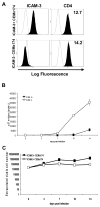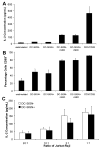ICAM-3 influences human immunodeficiency virus type 1 replication in CD4(+) T cells independent of DC-SIGN-mediated transmission
- PMID: 17434553
- PMCID: PMC1973158
- DOI: 10.1016/j.virol.2007.03.017
ICAM-3 influences human immunodeficiency virus type 1 replication in CD4(+) T cells independent of DC-SIGN-mediated transmission
Abstract
We investigated the role of ICAM-3 in DC-SIGN-mediated human immunodeficiency virus (HIV) infection of CD4(+) T cells. Our results demonstrate that ICAM-3 does not appear to play a role in DC-SIGN-mediated infection of CD4(+) T cells as virus is transmitted equally to ICAM-3(+) or ICAM-3(-) Jurkat T cells. However, HIV-1 replication is enhanced in ICAM-3(-) cells, suggesting that ICAM-3 may limit HIV-1 replication. Similar results were obtained when SIV replication was examined in ICAM-3(+) and ICAM-3(-) CEMx174 cells. Furthermore, while ICAM-3 has been proposed to play a co-stimulatory role in T cell activation, DC-SIGN expression on antigen presenting cells did not enhance antigen-dependent activation of T cells. Together, these data indicate that while ICAM-3 may influence HIV-1 replication, it does so independent of DC-SIGN-mediated virus transmission or activation of CD4(+) T cells.
Figures







Similar articles
-
Capture and transfer of simian immunodeficiency virus by macaque dendritic cells is enhanced by DC-SIGN.J Virol. 2002 Dec;76(23):11827-36. doi: 10.1128/jvi.76.23.11827-11836.2002. J Virol. 2002. PMID: 12414925 Free PMC article.
-
CD4 coexpression regulates DC-SIGN-mediated transmission of human immunodeficiency virus type 1.J Virol. 2007 Mar;81(5):2497-507. doi: 10.1128/JVI.01970-06. Epub 2006 Dec 6. J Virol. 2007. PMID: 17151103 Free PMC article.
-
The importance of virus-associated host ICAM-1 in human immunodeficiency virus type 1 dissemination depends on the cellular context.FASEB J. 2004 Aug;18(11):1294-6. doi: 10.1096/fj.04-1755fje. Epub 2004 Jun 18. FASEB J. 2004. PMID: 15208262
-
The role of DC-SIGN and DC-SIGNR in HIV and SIV attachment, infection, and transmission.Virology. 2001 Jul 20;286(1):1-6. doi: 10.1006/viro.2001.0975. Virology. 2001. PMID: 11448153 Review. No abstract available.
-
Molecular characterization of dendritic cells operating at the interface of innate or acquired immunity.Pathol Biol (Paris). 2003 Mar;51(2):61-3. doi: 10.1016/s0369-8114(03)00097-x. Pathol Biol (Paris). 2003. PMID: 12801801 Review.
Cited by
-
HIV-1 Gag associates with specific uropod-directed microdomains in a manner dependent on its MA highly basic region.J Virol. 2013 Jun;87(11):6441-54. doi: 10.1128/JVI.00040-13. Epub 2013 Mar 27. J Virol. 2013. PMID: 23536680 Free PMC article.
-
HIV-1 Trans Infection of CD4(+) T Cells by Professional Antigen Presenting Cells.Scientifica (Cairo). 2013;2013:164203. doi: 10.1155/2013/164203. Epub 2013 May 7. Scientifica (Cairo). 2013. PMID: 24278768 Free PMC article. Review.
-
Intercellular adhesion molecule 1 (ICAM-1), but not ICAM-2 and -3, is important for dendritic cell-mediated human immunodeficiency virus type 1 transmission.J Virol. 2009 May;83(9):4195-204. doi: 10.1128/JVI.00006-09. Epub 2009 Feb 11. J Virol. 2009. PMID: 19211748 Free PMC article.
-
Transcriptomic Analysis of the Spleen from Asian Seabass (Lates calcarifer) Infected with Infectious Spleen and Kidney Necrosis Virus.Viruses. 2025 May 19;17(5):728. doi: 10.3390/v17050728. Viruses. 2025. PMID: 40431739 Free PMC article.
-
Cellular and viral mechanisms of HIV-1 transmission mediated by dendritic cells.Adv Exp Med Biol. 2013;762:109-30. doi: 10.1007/978-1-4614-4433-6_4. Adv Exp Med Biol. 2013. PMID: 22975873 Free PMC article. Review.
References
-
- Baribaud F, Pohlmann S, Sparwasser T, Kimata MTY, Choi YK, Haggarty BS, Ahmad N, Macfarlan T, Edwards TG, Leslie GJ, Arnason J, Reinhart TA, Kimata JT, Littman DR, Hoxie JA, Doms RW. Functional and Antigenic Characterization of Human, Rhesus Macaque, Pigtailed Macaque, and Murine DC-SIGN. J Virol. 2001;75:10281–10289. - PMC - PubMed
-
- Berney SM, Schaan T, Alexander JS, Peterman G, Hoffman PA, Wolf RE, van der Heyde H, Atkinson TP. ICAM-3 (CD50) cross-linking augments signaling in CD3-activated peripheral human T lymphocytes. J Leukoc Biol. 1999;65:867–874. - PubMed
-
- Biggins JE, Yu Kimata MT, Kimata JT. Domains of macaque DC-SIGN essential for capture and transfer of simian immunodeficiency virus. Virology. 2004;324:194–203. - PubMed
Publication types
MeSH terms
Substances
Grants and funding
LinkOut - more resources
Full Text Sources
Research Materials

